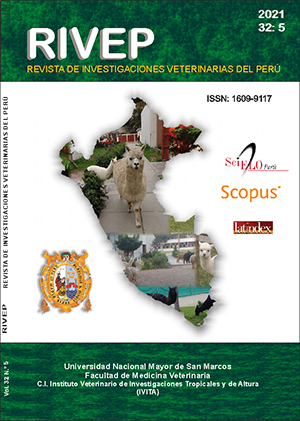Hyperendemicity of fascioliasis and risk factors in school-age children from the Orurillo district, Puno
DOI:
https://doi.org/10.15381/rivep.v32i5.19462Keywords:
fascioliasis, children, intestinal parasites, animal husbandry, food consumptionAbstract
The aim of this study was to determine the association of fasciolosis in school-age children with intestinal parasites, food consumption and animal husbandry. The research was analytical, prospective, cross-sectional, and relational. In total, 295 serological and stool samples were obtained, and an epidemiological interview was carried out on children of both sexes, aged 3 to 19 years from 23 institutions of initial, primary and secondary education, with the informed consent of their parents. The serological diagnosis was made using the IgG immunoblot technique and the IgG ELISA test and the stool diagnosis was made with the rapid sedimentation technique modified by Lumbreras. Risk factors were obtained by epidemiological interview. The prevalence of fasciolosis was 11.2% (95% CI = 7.4-14.9; 33/295). Significant differences were found between educational institutions and communities of origin. Both in univariate and multivariate analyses determined that drinking well water and raising guinea pigs were associated with fasciolosis.
Downloads
Downloads
Published
Issue
Section
License
Copyright (c) 2021 William Quispe P., María Beltrán F., Nury Vargas M., José Cabanillas A., Elizabeth Sánchez R., Aldo Valderrama P.

This work is licensed under a Creative Commons Attribution 4.0 International License.
AUTHORS RETAIN THEIR RIGHTS:
a. Authors retain their trade mark rights and patent, and also on any process or procedure described in the article.
b. Authors retain their right to share, copy, distribute, perform and publicly communicate their article (eg, to place their article in an institutional repository or publish it in a book), with an acknowledgment of its initial publication in the Revista de Investigaciones Veterinarias del Perú (RIVEP).
c. Authors retain theirs right to make a subsequent publication of their work, to use the article or any part thereof (eg a compilation of his papers, lecture notes, thesis, or a book), always indicating the source of publication (the originator of the work, journal, volume, number and date).










